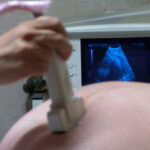Finding out you only have half a uterus can be a shocking and rather traumatic experience. I still remember the day I was diagnosed with what doctors term Unicornuate uterus. I had gone to a fertility specialist with the hope of conceiving our first child, and when the resident did a routine ultrasound of my pelvis to rule out uterine issues, she couldn’t locate my uterus at all. With the help of the physician, she managed to find it- all on the left side of my body and none on the right.
I was scheduled for an HSG (hysterosalpingogram) the following week. The test would involve a doctor inserting a catheter into my uterus and injecting dye while following the process on an x-ray machine. Sure enough, the only space to fill on my x-ray screen was the left side. I was scheduled the following week for another x-ray to confirm that I had two kidneys as many women with this disorder also only have one kidney. Thankfully, I had both kidneys which, at the time, was small consolation.
Unicornuate uterus is a birth defect where either only one side of the uterus forms, or both sides form but one side is extremely stunted and not connected to a fallopian tube. The stunted side forms a small pocket and often does not have an outlet to the cervix. This small pocket is called a rudimentary horn, and is often the source of extreme pain when the menstrual cycle commences during puberty. Because the horn generally has a lining, it sheds during a normal cycle but has no way of leaving the body. Generally, if a horn is present, Unicornuate uterus (UU for short) is diagnosed in adolescence, and the horn can be removed surgically.
I was lucky and had no rudimentary horn. What I had was exactly half of the uterus I should have, with a left fallopian tube and ovary connected to the tiny organ that was my uterus. Also present was a small right tube and ovary, which was not connected to anything at all.
Dealing with this issue, considering I wanted to get pregnant, was a touchy one, both emotionally and practically. UU doesn’t directly lead to any extra fertility problems, but since only one side is connected to a fallopian tube and ovary, fertility is generally considered to be at 50% of normal. However, with the advent of fertility drugs, it’s possible to ovulate on the correct side each month, bringing the fertility level back to 100%.
More complicated is carrying a child. I was lucky enough to get pregnant my third cycle with the fertility specialist, but there was a serious problem. An errant sperm had jumped out of my uterus and made its way to my right fallopian tube, where it promptly fertilized one of the eggs produced with the fertility treatments. Since the right tube was not connected to my uterus and since it was extremely stunted, the newly fertilized egg couldn’t get back out of the tube and implanted, causing an ectopic pregnancy. My right tube was removed surgically and, after a recovery period, we attempted another cycle.
Many women have a “dominant” ovary. That is, an ovary which produces better quality eggs, and perhaps ovulates more often than the other side. Unfortunately for me, my right side was that ovary. Without a tube and without a uterus, it persisted in producing the best eggs at nearly every cycle. I faithfully continued to take fertility drugs, however, hoping that one cycle, a decent egg would be produced on the left side- the correct, normal side.
Sure enough, in January, everything was right. I produced a large egg on the right side and was able to get pregnant. Now the real fun could begin!
However, pregnancy for a woman with a Unicornuate uterus is not all fun and games. Because the uterus is half the size of a normal organ, carrying one fetus is like carrying twins. Hence, the risk of preterm labor is the same as that for a multiple pregnancy, and there’s also the chance that the cervix, due to the pressure on it, will give up before full term.
Working with a high risk OB is essential in these cases, and I’ve been fortunate to have a wonderful doctor. Cervical measurements have been taken on me throughout my pregnancy- early as a baseline and later to determine if the cervix is shortening, which can be a sign of impending preterm labor.
Delivery is also difficult. Because there is only half a uterus, the fetus cannot come straight out of the cervix as in a normal delivery. There is a slight turn to be navigated, and some fetuses have trouble making that turn. Breech babies are also very common in pregnancies involving uterine anomalies because, by the time the baby is ready to turn, there is literally no room to do so. Because of these two issues, a Cesarean Section might be preferred to a vaginal delivery.
I’ve been lucky so far to have a normal, healthy pregnancy. However, every woman is different, and every doctor has different standards of caution when it comes to UU pregnancy and childbirth. The best thing for any woman who has an anomaly and is considering pregnancy is to have a frank and honest conversation with her doctor regarding the risks and treatments.





